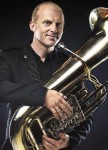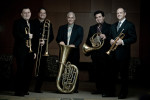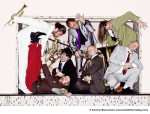1. Traveling (a great deal!), with the tuba presents a challenge. When you fly, does the tuba go underneath? (If so, do you have a special case?). How many tubas do you most often take with you when you fly? Any funny stories on land or sea?
When traveling, I only bring my trusted Miraphone Starlight Eb tuba. I have toured with small planes, sea planes, large planes, helicopters, all kinds of cars, busses, various bikes, tractors, trucks, a rowing boat, fishing boats, really fast boats, huge boats and of course ferry. Pretty much everything but a submarine.
There have been numerous funny, and many not so funny stories, connected to flying.
One of the most memorable was going with Lufthansa from Frankfurt to Linz in Austria. I had packed the tuba inside a gig bag and then put the bag in a carbon fibre case.
Just before take off I look out the window and notice my tuba standing on the concrete next to the plane. Worrisome (!), so I notify the flight attendant. Oh, don’t worry, it is probably not your tuba, she replies. Yes it is! I have a gig this evening and NEED it to be on the plane, I told her. I left my chair and followed her up to the area outside the cockpit. It turned out the luggage compartment of the mid sized plane was full so my tuba would not fit. After arguing for ten minutes with several crew members, the cockpit door opens and the captain puts his head out. What’s going on he asks. While still on the ground I explain the desperate situation to him. He must have been a music lover because he makes a few phone calls, probably to check the regulations, then suggests to bring the tuba inside the cockpit!
The crew opens the plane door, I am handed one of those orange wests and walk on to the runway to “identify” my tuba.
In front of a full plane of impatient passengers, looking like question marks, I bring the entire case inside the cabin and try to stuff it through the cockpit door. The door is too narrow. Damn, what now? Wait, I can leave the case behind and put the tuba with gig bag inside the cockpit. Said and done. Thanks Lufthansa pilots for saving the concert!
2. Tell us about growing up in Norway: How close was your nearest neighbor/how big was your town as a child? What kind of things happened when it was too cold to go out? Is there a part of you that was forged away from access to the Internet and people that is vital to what you do now?
I grew up on the country side with the nearest neighbor just 20-30 meters away. I guess they learned to live with the tuba sound.
You can’t really call it a town. More a large area with agriculture. Amongst those 3000 people living there, we had four wind orchestras, three choirs and several smaller music groups.
It was never too cold to go out. Like most of the country, this part of Norway is close to the ocean, which means less extreme temperatures.
I have often wondered if the absence of Internet made a difference. For sure, we had other things that could steal our time! That being said, I think that today’s youth might need even more discipline to avoid having all their time being consumed by Internet use. Loosing focus is another challenge.
My wife is very important for what I am doing right now. Both for general inspiration as well as a musical discussion partner.
 3. If a genie appeared and said that you and your tuba could take the place of ANY and musician and ANY instrument for a combination of any three concerts or albums, which three situations would you choose?
3. If a genie appeared and said that you and your tuba could take the place of ANY and musician and ANY instrument for a combination of any three concerts or albums, which three situations would you choose?
I can’t really think of any.
4. Arnold Jacobs extolled and inspired us all to become “story tellers of sound”, but in your case you seem (at times), utterly absorbed by the emotional content. Do you allow yourself to become deeply involved in the emotion of a piece, and what does it demand from your attention?
Personally I have always found Jacob’s statement confusing. Music to me is not about telling a story. Reading literature is, or perhaps singing a text. Instrumental music is much more abstract and about a series of emotional characters. Sometimes happy and sometimes sad, and everything in between.
In fact, I find it very liberating NOT having to construct a story. And when listening, to be free to construct my own personal dream castle inside my head. Totally different from the person next to me.
The result is that the spirit of music is freer, more individual on both the sending and receiving end.
It does not mean however, that you don’t need knowledge to perform music.
What you need is a deep knowledge about how to create musical and emotional characters, or archetypes, and how they work together.
A musical archetype is a way of phrasing that is immediately recognized by the audience as a particular character. For example, what technical tricks must we pull off to make the music sound romantic? Or espressivo, or joyful, or wild?
When playing, we should not let a bar go by without knowing what character we want in this particular bar, or even on this particular note.
Constructing long series of characters in combination with an immense focus on the present, makes for a good performance.
When audiences see me on stage as “utterly absorbed by the emotional content”, what they really see is me being focused on the present moment, trying to maximize the musical character that I am working just now.
Here is a transcribed quote from an actor:
One of the most important things in music is honesty. When you have learned how to fake that, you have come a long way!
This statement sound like a cynical joke, and most of the time it is.
However, there is much truth to it.
Music without emotional involvement is worthless.
On the other hand, musicians can’t allow themselves to get carried way beyond control.
What we should try though is to find the tipping point. The point where everything collapses because of too much involvement. A good performance balances constantly on this knife edge between rock hard control and emotional breakdown.
5. How do you choose literature? Are there some things you feel audiences are not yet ready to hear on the tuba?
I choose music that allows me to explore interesting musical characters. I don’t like pieces that “plays themselves” and where the composer has reduced the musician to a note machine. “Just play what’s on the paper and all will be fine.”
Not ready to hear on the tuba? Not really, except boring playing.
 6. On the tuba that you most frequently use, which ranges are the most effective and for what purposes?
6. On the tuba that you most frequently use, which ranges are the most effective and for what purposes?
Do you sometimes hear dynamics and ranges as merely different colors?
I tend to play mostly in the mid and high register. Dynamics and ranges are merely tools for creating musical characters.
7. How did you learn to phrase so beautifully? Do you conceive of, plan or mark phrasing in a special way?
I experiment a lot and I analyze great performances by others. I ask myself, what is it that makes this phrasing sound so organic and beautiful. I look at the use of unwritten tools such as timing (agogic), dynamics, accents, tenures, vibrato etc. Then I try to imitate. I record myself a lot so that I can hear where I might improve.
What I have found is that what sounds natural is often far from it. In other words, we have to do some pretty unnatural things in order to have the music sound natural!
The good thing is that we humans are flexible and with some practice we can make almost anything feel natural.
8. Although nurtured by and (an integral part of) the brass/wind community, your opportunities have taken you into broader circles of musicians, and even beyond the circle of musicians to artists and cultural figures. What have you discovered as a man of artistic temperament in your travels and encounters?
Rimsky Korsakov describes the different orchestral instruments in his book about orchestration.
He describes the brass as being great for signals and dramatic highlights. When he wants richness of colors and beautiful melodies he turns to the strings, sometimes the woodwinds.
These definitions are very common amongst 90% of the composers that are played by modern orchestras.
Modern brass teaching is mostly about making the student ready for an orchestra gig and less about creating soloists. Therefore, it would be strange if the teacher did not focus on this demand for “signals and dramatic highlights” in the orchestra, and less on exploring colors and melodic playing.
We all try to fulfill the expectations put on us.
That is why a soloist must also look to other instrument groups for inspiration.
I have had the fortune of meeting some fantastic musicians over the years, and learned  from all of them. The latest encounter was the fantastic Indian violinist Subramaniam with whom I now have played many concerts. Look him up! He is right now writing a double concerto for violin, tuba and orchestra.
from all of them. The latest encounter was the fantastic Indian violinist Subramaniam with whom I now have played many concerts. Look him up! He is right now writing a double concerto for violin, tuba and orchestra.
9. Other than tuba, which three instruments/musicians fascinate you, and why?
I am fascinated by the violin, the voice and the piano. Partly because of the enormous repertoire between them. Partly because composers and performers through hundreds of years have explored almost all existing characters they can produce. I represents a veritable ocean of knowledge and experience.
At the same time, I am glad that I play the tuba. Compared to the violin the tuba is still in the kindergarten when it comes to exploring and using articulations, colors and musical characters.
c. 2015 David William Brubeck All Rights Reserved. davidbrubeck.com
Images courtesy of Mirafone and worldmusiccentral.org
MORE GREAT INTERVIEWS!
Jim Self
John Van Houten
Demondrae Thurman





 <
<
